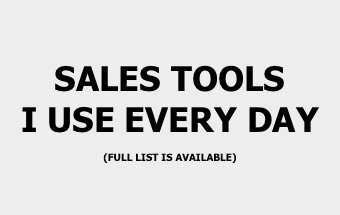Nowadays, very few people pick up the phone to get business done. Email, text or chat has become the preferred channel of communication.
But, if you really want to get things done. You have to actually talk to people.
Whether it’s your customers, partners, suppliers, investors or anybody else; you have to pick up the phone and call them.
Why?
Because business is fundamentally built around relationships. And real relationships are not built from ones and zeros (computer language).
I spend fifty percent of my time calling people every day. With the rest of my time used to send emails and do research.
I traditionally call general counsels and associate general counsels at large companies ($100M+ in revenue). Tough people to get on the phone.
Today, I’m going to share with you six strategies on how to get anybody on the phone. I shared these sames strategies with members of the Senator Club. And today I’m publishing them for you.
#1 Know who you want to call
Get really specific when you define who you want to call. Presumably there isn’t just one person you want to call. But rather, a specific profile of people you want to call. For example:
- I call General Counsels at companies with revenue greater than $100M, within the government, technology, energy and healthcare sectors, headquartered in either Canada or North America.
All too often when you ask founders of startups, “who are you selling to?” You may hear something as misguided as:
- We sell to female moms with kids.
Know who you want to call first. The more specific you can be to define the “who”. The easier your calls will be.
#2 Do enough information gathering
The last thing you want to be is unprepared. So do enough information gathering before you pick up the phone. The most important data points, in order of priority, are as follows:
- name
- company
- job title
- phone number
- location
- source
- skills
- expertise
- interests
Now, here are the best places to find this data. The company website, , Rapportive, Radius, Data.com, Hoovers, Crunchbase, and AngelList.
As you collect the data, add it to your CRM. What you don’t have a CRM? Ok. I’ll write about the best tools for that later.
In the meantime, let’s assume you do. Which brings me to my next point.
#3 Write more detailed notes in your CRM
Sales people are notoriously bad at entering notes in their CRM. Mostly because we think it’s an administrative activity. Therefore, rather than waste time typing up our notes, we can add more value if make more calls.
This kind of thinking is very short-sighted.
Make note of all your activity. Include calls attempt made, emails sent, and info gathered from assistants. Notes don’t have to be long. keep them less than a few sentences, and use abbreviated words.
Your past activity provides guidance to a clear strategy going forward.
#4 Make calls with a clear strategy
I think it’s best to share an example of my strategy when calling a lead. I set my call strategy based on the source of the lead and their response to my efforts.
So, when I receive a high priority inbound lead, this is how I take action:
- Day 1: make immediate call, and send email
- Day 2: make second call
- Day 3-4: make third call
- Day 5-7: make fourth call, and send email
- Day 8-10: make fifth call, and send email
- Day 11: make sixth call, and LVM
You may be thinking, that’s way too many calls and emails. Well, you need to be persistent if you want to get them on the phone. Respectful, but persistent.
#5 Get assistants to trust you
Assistants are the dreaded gatekeepers. The absolute best way to get past them is to get them to trust you.
How do you get assistants to trust you?
Your tell them the TRUTH!
I asked all the assistants at my current company and my previous companies. And they all said, the people they help are those who are HONEST about their intentions.
Tell them why you are calling and why it matters to the person you are calling.
You are lucky if you get by the first time. Expect to make numerous calls and send a few emails, sometimes cc’ing the assistant.
Here’s a bonus tip for you. Get value from every call you make. If the assistant won’t put you through, ask them a qualifying question to gather more information. Such as, “do you know if Mr. Smith is involved in ______?”
#6 Find someone else to refer you
Lastly, if you can’t make direct contact via phone or email, get someone to refer you.
In fact, do business through referrals as often as you can. This is the best way to get anybody on the phone.
Referrals are more realistic when you are targeting a small group of people. Because when you are calling 50+ people a day, it’s hard to consistently generate that many referrals.
Something to think about though when structuring your business. Referrals are so powerful and effective.
BONUS IDEA
Become someone that others want to talk to. When Elon Musk calls somebody, you can bet he gets called back.
Conclusion
No matter who you want to get on the phone, the six strategies above will guide you. Know who you want to call, and get specific. Then do enough information gathering so you are prepared. Write more detailed notes in your CRM which will help you make calls with a clear strategy. Get assistants to trust you by telling them the truth. And most importantly, harness the power of referrals.
You can download the original power-point presentation I gave to the Senator Club here. Or view here:
I hope this helps you get anybody on the phone. It continues to work for me. Can you think of other helpful ideas to get anybody on the phone?





7 Comments How Sales Pros Get Anybody on the Phone